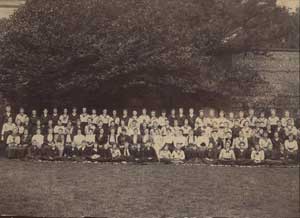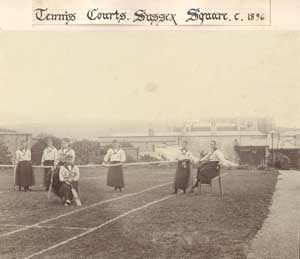The History of 35 Sussex Square
ROEDEAN HISTORY 35 Sussex Square
It was in the autumn of 1885 when the three elder Lawrence sisters, Penelope, Millicent and Dorothy moved from the family home in Wimbledon to No 25 Lewes Crescent, Kemptown, and opened a school.
The family of 14 children had fallen on hard times after their father, Philip Henry Lawrence, a barrister, was invalided in a climbing accident in 1881. Millicent and Dorothy, who were both trained teachers and had been teaching their younger siblings at home, decided they must add some boarders and neighbours’ children to make ends meet.
However after four years they came to the conclusion it was impractical to run a school as a paying concern with an invalid father and small children in the house; so they persuaded their elder sister, Penelope, who had studied sciences at Newnham, Cambridge, to join them in their venture to open a school in Brighton.
The three sisters started with 10 pupils, ‘six paying and four for show,’ according to Penelope. A year later, having increased to 18 pupils, the new school took over No 3 Arundel Terrace for the younger girls, the older ones remaining at No 25. By 1887 further accommodation was needed so No 26 was added and openings made through to No 25. The same year lodgings at No 37 Chesham Road were taken to house the sanatorium where pupils with infectious diseases could be isolated. By 1890 the school was growing apace so the Principals acquired three houses in Sussex Square, Nos 35, 36 and 37, which had previously been a boys’ preparatory school. In 1892, No 34, then known as Iken House, was added and No 29 in 1893.

The following passage from Dorothy E. de Zouche’s book published in 1955, ‘Roedean School 1885 – 1955’ describes the Sussex Square environs in some detail:
‘The householders of Sussex Square had originally long, narrow gardens, those on the eastern side extending as far as Arundel Street, where the stables and coach-houses once were and Messrs. Wilson’s Laundry now stands. When Bristol Place was driven from north to south through these gardens, connecting two important east-to-west roads, the householders caused subterranean passages to be made under it and so obtained access to their several domains. From No 36 the Lawrences’ pupils trooped through gas-lit tunnels to the great gymnasium erected by the previous tenant for the boys, which was furnished with a platform at one end and amply accommodated school assembly, concerts, and dramatic performances. Now the Recreation Room of Messrs. Wilson’s staff, it was recently shown to the writer, with several of the old tunnels. All these are now bricked up at one end if not both – some of them were used as air-raid shelters during the War – but it is still possible to traverse the whole width of Bristol Place underground and to visualize hilarious companies of school-girls in daily transit.

In Sussex Square, the School had other new amenities besides the gymnasium. There was a preparation room distinct from the classrooms, with individual desks made to Miss Lawrence’s own design; there was a girls’ drawing-room with a good floor for dancing; there were studies for prefects and cubicles in the bedrooms; there was central heating; there was ample garden space and Miss Lanchester planted rare and lovely flowers in the garden of No 36.’
The school, which according to the first prospectus was ‘to give a thorough education, physical, intellectual and moral’ had a relaxed family atmosphere with no uniforms and few rules. The philosophy was to allow pupils ‘as much liberty as is consistent with safety’. It was clearly successful and not only rescued the Lawrence family from financial disaster but also educated the younger children and enabled Mr and Mrs Lawrence to live comfortably and free from worry.
Roedean moved to its present location in 1898
Reference: Roedean School 1885 – 1955 by Dorothy E.de Zouche
Ann Longley Head Mistress 1984 – 1997